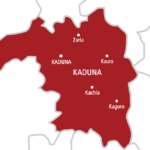Akinola Olunuwoade is yet to recover from the destruction of his crops. His farmland was completely damaged a few months ago after a gas emission from the Kaduna Refinery and Petrochemical Company (KRPC) damaged many farmlands including that of Olunuwoade in Kapam community of Chikun Local Government Area of Kaduna State.
The farmer and resident of Kapam said he had collected a loan to plant about 1,500 bags of yams, potatoes and beans which he has now lost due to the gas emission.
While farmers worried about the damage done to their farmlands, others such as Paulina Gideon, a mother and native of Kapam had inhaled the gas, fainted, and was rushed to the hospital. Days later, she was dismissed from the hospital without fully recovering. She now battles for her life, complaining of chest pain whenever she breathes and says she cannot explain what is wrong with her health.
Three months ago, a gas emission from the Kaduna Refinery and Petrochemical Company (KRPC) led to an environmental catastrophe, leaving residents of Kapam, a serene farming community in Chikun LGA grappling with destroyed crops, health concerns, and shattered livelihoods.
- Addressing farmer-herder conflicts in northern Nigeria: A pathway to rural peace
- Nigeria was good to my generation, says Prof Jibrin at 70
The incident, which was attributed to the accidental discharge of gas, resulted in the destruction of farmlands and animals, forcing the community to storm the refinery premises in a protest to express their displeasure.
However, a former member of the Kaduna State House of Assembly who represented Chikun state constituency and also an Analytical Chemist by profession, Marcus Zarmi Yari revealed that the gas that emitted from KRPC was hydrogen fluoride which had been stored for years because of non-activities in the refinery.
He said the inability of the refinery to deactivate their potency had given rise to leakage.
Yari disclosed that having visited the area that experienced the leakage, and based on the component of hydrofluoric acid which is lighter than air, when emitted, it goes straight into the atmosphere. “During that process of emission, the relative humidity was high and so the gas mixed with high humidity and became an acid rain. That is the simple chemical explanation of what happened,” he said.
The Analytical Chemist further said: “When the droplet now dropped as acid rain, it came down as hydrofluoric acid and any contact with green vegetation will leave a devastating effect. It will affect the chlorophane,” adding that once the chlorophane is affected, the crops will die as evident in what happened in Kapam community.
While reacting to the health implication of the gas on humans, he noted that inhalation of the gas itself affects human internal organs and can last a long period.
The Kaduna State government, through the Ministry of Environment and Natural Resources when contacted said Governor Uba Sani had directed the commissioner to convey a critical stakeholder briefing of both the state and federal government agencies.
A director in the ministry, Yusuf Muazu, said after consulting with the parties involved, they had moved for an on-the-spot assessment to prepare better recommendations and steps to be taken. This he said included a visit to Kapam community to assess the level of damage and destruction to the health and livelihoods of the people.
He said the community was assured that the government would do everything possible to curtail future occurrences of the incident and necessary measures taken to ensure that they are duly compensated.
Muazu said the delegated team had then moved into KRPC to meet with the management where he said it was confirmed that there was indeed an accidental discharge of hydrogen fluoride gas.
“It has been there for more than 20 years and with the moisture, the taps had a problem in the process of amending it, that was why the accidental discharge occurred but immediately, they were able to contain it even though part of it had escaped,” he said.
He told this newspaper that a Technical Committee was formed to come up with findings so that the necessary compensation would be paid.
The director disclosed that at the time of their visit, some of the community members were battling with health challenges and had been conveyed to hospitals as part of the resolution reached with KPRC to ensure that all health issues were treated accordingly.
Samson Barde, a resident of Kapam confirmed that a team of doctors and soil scientists had visited the community shortly after the incident to assess the level of damage. He, however, said the doctors spent just two days without attending to all those exposed to the gas. Residents explained that the effect of the chemical on their health was devastating as some of them were vomiting, coughing and were letter admitted in the hospital.
Barde explained that the doctors sent to the community had conducted brief medical checkups and distributed malaria drugs while the soil scientists had taken samples of the soil and affected crops. But three months later, he said they were yet to return.
Mary Felix, another resident, said she suffers from high blood pressure and dizziness as a result of chemical odours she inhales from ongoing activities in the refinery. Like her, other residents claimed the air is polluted at intervals and many are battling with different health challenges. This reporter further gathered that some residents are considering relocating from the community. They insist both water and soil have been contaminated and not many can cope with buying table water daily.
At the time of visit, Our reporter found that for the predominantly farming community of Kapam, life has not returned to normal. With their crops destroyed and many battling ill health, residents wonder how they would survive without food.
“When the incident happened, KRPC did not show concern until our people here protested. Everybody in Kapam lost everything they farmed. Many people farmed maize, beans and potatoes among other crops but lost everything,” said Akinola Olunuwoade, a father and husband who lost over 1,500 bags of yam, potatoes and beans to the gas pollution.
“It was after the protest that KRPC said they were going to compensate people,” he said and added that though the company had made a lot of promises to the community, they were yet to visit to take inventory on the losses incurred.
Despite the health crisis and ecological destruction, Kapam residents have yet to receive any form of compensation or assistance. Effort to get the KRPC to respond to the plight of the community members were to no avail. Our correspondent was told by a staff member that they had been directed not to speak on the issue.
A letter was written to the Nigeria National Petroleum Company Limited (NNPCL) requesting an interview, but there was no response as at the time of this publication.
Three months after the accidental gas leakage, the leaders of the Kapam community say they are yet to meet with the management of KRPC as they were told the manager in question was ill. However, Marcus Zarmi Yari said the management of KRPC had promised to call them for an interface but had yet to do so.
“You see, what we are calling for is that there is an accident and it should be treated as an accident. This is an accident that happened and everybody saw it. Then, what do you do to cushion the effect of the accident? It is neither the fault of the NNPC nor the community but because we are part of the government too, I think there are provisions for such emission,” Yari said, adding that the laws are clear on what KRPC needs to do.
“Remember, in the community there are people that will not understand when you are talking about law. We are telling them to take it easy not because they don’t have power to do one or two things. But once we are tired, we cannot hold them because we don’t have the capacity to feed them. I thought by now, NNPC would have done the right thing. I am not mincing words, there may come a time we may not have the strength to hold back the people,” he said
As Kapam residents continue to grapple with the fallout from the gas emission, their patience appears to be wearing thin. Many worry that the delayed response signals an attempt to sweep the disaster under the rug. For now, the community is left with unanswered questions, worsening hardship, and a growing sense of abandonment.

 Join Daily Trust WhatsApp Community For Quick Access To News and Happenings Around You.
Join Daily Trust WhatsApp Community For Quick Access To News and Happenings Around You.


